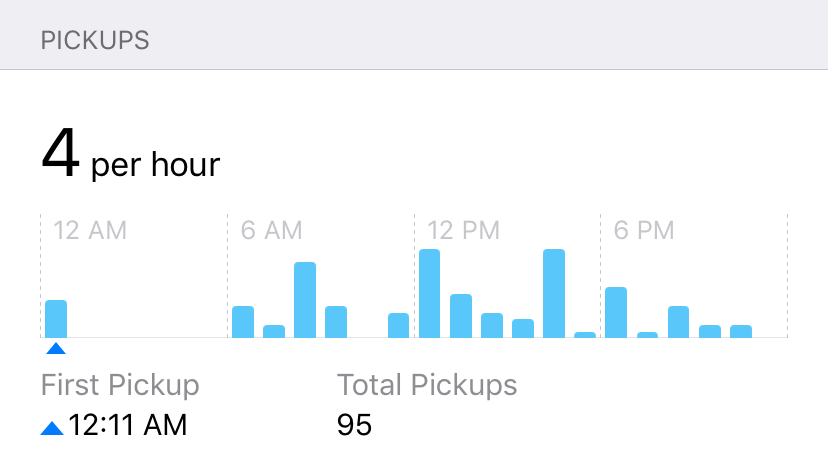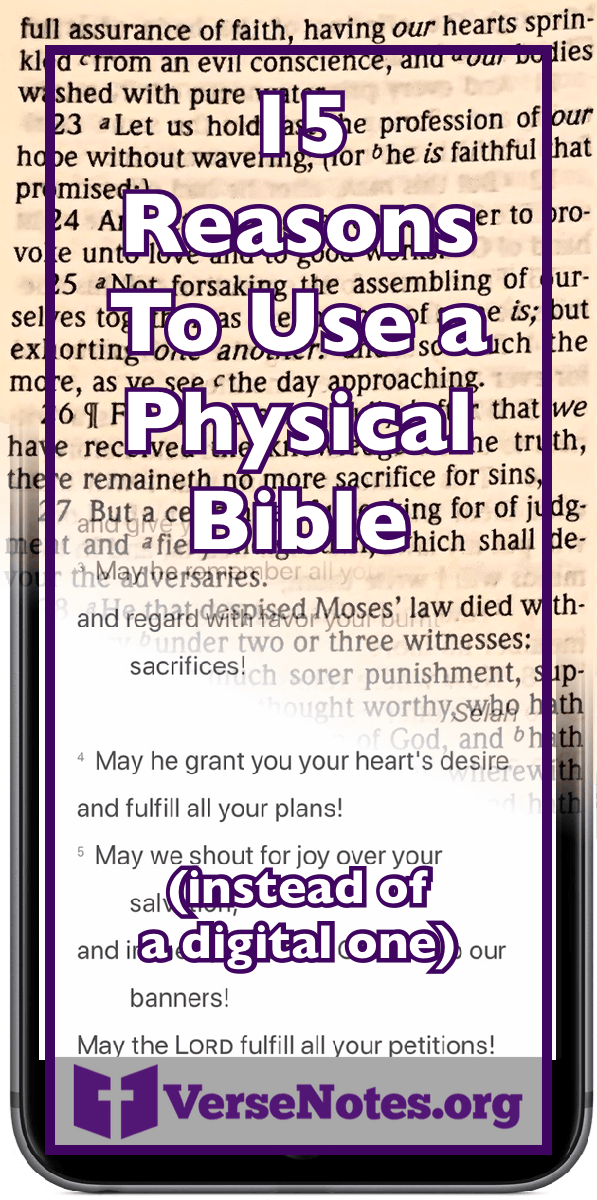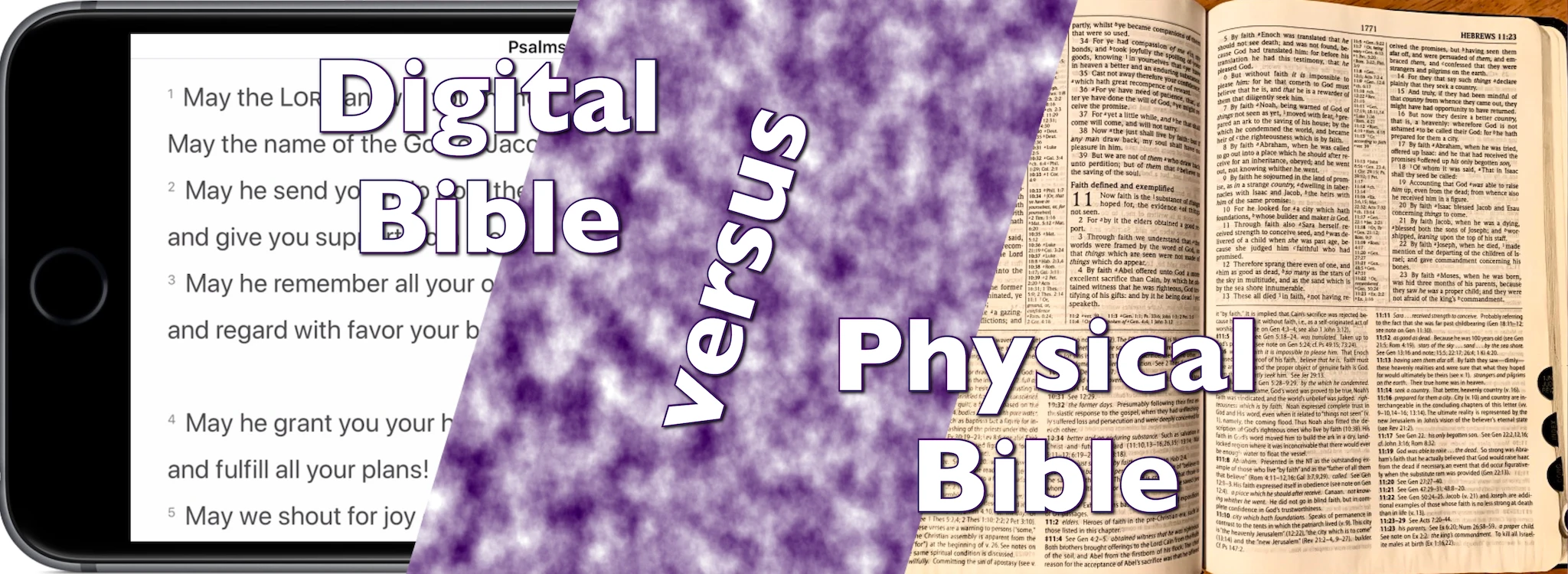15 Reasons to Use a Physical Bible Instead of a Digital Bible
This post is part of the series “Digital Bible vs Physical Bible”
-
15 Reasons to Use a Digital Bible Instead of a Physical Bible
-
15 Reasons to Use a Physical Bible Instead of a Digital Bible 👈 you are here
Every morning I wake up, ignore the alarm, wake up again, fix coffee and breakfast, and sit down to read my Bible. Most days, that’s actually what happens—I unlock my phone, tap the YouVersion Bible app, and start my reading plan. But some days, like today, for instance, my thumb finds Tweetbot instead. Or, worse, Mail. And down the rabbit hole I go.
Ten or fifteen minutes later, when I realize what I’m doing, I close the app, open up the Bible app, and wonder if I should switch from a digital Bible to a physical Bible for my daily devotional. After all, I have this gorgeous black Zondervan King James study Bible sitting back in the bedroom. I’ve been asking myself this question for years now, so I finally decided to sit down and have it out.
This post is a list of every reason I could think of to use a physical Bible instead of a digital one. Its companion post is a list of every reason I could think of to use a digital Bible instead of a physical one. Read both lists, and see which one is more convincing to you. At the end, I’ll tell you what I settled on.
Physical Bible Versus Digital Bible: Reasons to Choose a Physical Bible
1. A physical Bible limits your distractions.
Your phone or tablet is an endless well of distraction. Or at least, mine is. Before you even open your Bible app, there are notifications on the lock screen. When you get the phone unlocked, there are more than a dozen other apps competing for your thumb tap—assuming your Bible app is even on your home screen. After you start reading, new notifications keep coming in. Properly preparing your phone can prevent some of these distractions, but a physical Bible doesn’t have them in the first place. Just you and some paper and ink and the Holy Spirit.
2. A physical Bible sets your time apart.
I keep reading these stories that say we touch our phones some outrageous number of times each day. I keep thinking I’m the exception. But I had an incredibly busy day today at work, and I… well… look.

If you pick up your phone all day every day, what’s different about your time in the Word? It’s no different to your brain or your hands than scrolling through Twitter, or Instagram, or Facebook, or your favorite website or news app. Reading the Bible should be unique, special. It should feel different to your mind and body than the rest of your day.
3. A physical Bible teaches you the structure of the Bible.
In short, you can’t open to Jude if you don’t know where the book of Jude is. My favorite Bible reading plan, the Discipleship Journal Reading Plan, includes readings from four different sections of the Bible every day. Spend a year flipping to the same books four times a day, and you’ll figure out where they are in a hurry. “But Jerry, why do I care about the structure of the Bible?” That needs a post of its own, but in short: history, story, and witness. The structure of the Bible is tied to the history of the Bible, the order of the books helps tell its story, and knowing where books are helps you demonstrate your love of the Word.
4. A physical Bible limits your translation choices.
A Bible app may have hundreds of translations available. Your physical Bible has exactly one1. To be fair, some Bible apps only offer one translation, such as the aptly named ESV Bible app. But if you’re worried about whether NET or NASB might have better words than whatever you’re reading, you’re not listening as well to what God is saying. A physical Bible makes the choice for you. There are other reasons to stick to one translation; in particular, memorization and recall are easier if you focus on just one. But even if you’re not trying to memorize a passage, taking away that choice removes an excuse not to start reading, avoids decision paralysis, and helps you spend time with the Word instead of spending time on the words.
5. A physical Bible helps you remember what you’ve read.
This one might be particular to me. When I’m trying to remember something I’ve read, being able to visualize the page helps me remember it: “I know it was at the top of a right-hand page with one long paragraph and two short paragraphs…” I’ve used this technique since at least high school to remember passages from novels, facts and equations from textbooks, lines of poems, and of course, stories from the Bible. That’s only possible with a physical Bible that you read out of all the time. Right now as I write, I can visualize all of Genesis 1 and most of Hebrews from the paper Zondervan KJV sitting next to me, but I have no idea what any of those passages looks like on my phone. They all look the same on that infinite scrolling screen.
6. A physical Bible presents the Word as it was written.
You may have heard that the Bible is a library full of different genres of literature: history, poetry, prophecy, and more. Sometimes, the structure of the text is important: line breaks, repeated words, or quotations. Because even the largest phone is small next to most Bibles, you often have to turn your Bible sideways just to display correctly. Not so with physical Bibles: they have the room to present the text as the translators intended, so you can grasp the full meaning of what you’re reading.
7. A physical Bible keeps context together.
The screen size of a phone means you can’t see the surrounding passages of the verse you’re reading. You’re limited to maybe four verses before and after. When you navigate to a verse, you can see only that verse, not the previous story or the next one. For example, let’s say you’re reading the parable of the lost coin (Luke 15:8–10). In a physical Bible, you’ll immediately notice that it’s pinned in between the parable of the lost sheep and the parable of the prodigal son. You’ll ask yourself, “Hey, what do these stories have in common?” And you’ll understand that Jesus is telling the same story three ways. With a digital Bible, you’ll be lucky to see the heading and the three relevant verses.
8. A physical Bible lets you see chapters together.
As I read through my Bible, I keep track of where the chapter breaks make no sense. It’s disturbingly often that a story gets broken right in two by a chapter marking. Consider, as a famous example, Genesis 2:1–3. They clearly belong with the story of Genesis 1, but for some reason, they’re lumped with Genesis 2. A physical Bible would let you see that, because it doesn’t separate chapters except by headings (and I kind of wish they wouldn’t even do that). Some digital Bibles, however, make it impossible to see the end of one chapter and the beginning of the next at the same time. The ESV Bible app is a good example of one that doesn’t have that problem; but YouVersion and NeuBible, on the other hand, absolutely do.
9. A physical Bible looks like a physical Bible.
I know this sounds ridiculous, but let me tell you a story. About four years ago, I went on a mission trip with my church’s high school students. Our first night, we attended a church service that was standing room only, and we stood in the back. When the sermon started, I—as always—pulled out my phone to take notes. A few seconds later, one of the other leaders jabbed me to put away my phone. I explained, of course, that I was typing out sermon notes and looking up Bible references, but she correctly pointed out that nobody else knew that. For all the students knew, I was browsing Instagram or texting my friends back home. The same is true sitting in a pew: it looks like you’re swiping through cat pictures instead of reading along. But a physical Bible is unmistakeable. Nobody wonders whether there are cat pictures inside (there aren’t).
10. A physical Bible makes note-taking easy.
Just write it down, right there, on the page, next to the verse. The next time you come across that verse, the note will be right there! You won’t have to tap your screen to check if you took a note, or wonder if maybe you wrote it in another app, or anywhere at all. It’ll just be there, right alongside the text.
11. A physical Bible gives you space to draw.
I am not one of those who decorates their Bibles. But there are plenty who do, and it helps them organize their thoughts and process a passage. Do a quick Pinterest search for “Bible journaling”, and you’ll find some beautiful examples of folks whose journey is helped by color. That’s basically impossible to do in a Bible app.
12. A physical Bible leaves a legacy.
For hundreds of years, people have passed down Bibles with records of births, baptisms, marriages, and deaths. In some communities, family Bibles are the only record of these events, the only memory that some people ever lived. When one of my great-aunts died, her personal Bible ended up on my parents’ bookshelf. When we opened it, we found a treasure trove of artifacts she had collected over her life: scraps of paper, bookmarks, notes, and even a pressed leaf from a trip to Jerusalem. I’ve heard other stories of reading a loved one’s Bible and learning about their hopes and fears and dreams, seeing which pages were worn thin and prayed over, and feeling just a little closer to those we’ve lost. Good luck doing that with an app2.
13. A physical Bible can be flipped through.
Sometimes, I just sit down and flip through a Bible to see what’s in there. Maybe I’m reminded of a story I haven’t read in a while. Maybe there’s a diagram of Solomon’s temple. Maybe a map of what Israel looked like when Joshua crossed the Jordan, and another after David finished his wars. Digital Bibles tend to sequester all those things into separate part of the app, instead of right in line with the text. And of course, with a digital Bible, there’s no serendipity to what you read. Maybe some of these apps should add a “random passage” button. I would click it. A lot.
14. A physical Bible can have bookmarks.
I’m sure there are ways to bookmark digital Bible passages. YouVersion, for instance, has a virtual highlighter, and you can find a list of everything you’ve ever highlighted. My list, of course, is hundreds of verses long, and I can’t find anything when I go looking for it. But the single bookmark in my physical Bible is stuck right at Ephesians 6, as it has been for years, so I can open right to these words: “Wherefore take unto you the whole armour of God, that ye may be able to withstand in the evil day, and having done all, to stand.” Beautiful. Encouraging. Comforting. And always there.
15. A physical Bible requires no battery.
It’s kind of weird to think about a battery-powered Bible, but that’s what a digital Bible is. There’s always a chance you can’t get to it when you want it or need it. Maybe you’ve never had this problem, but with a book, you never will.
Which Kind of Bible Is Right for You?
I hope you’ve seen that there are great reasons to choose a physical Bible for your reading. Every time I pick mine up, I am reminded how nice it feels to have the cover in my hand, to remember the feel of the pages and the shapes of the words. To feel the weight of a thing that has only one purpose: to know the Word of God.
But a physical Bible is big and heavy, and it’s not always with me, and frankly I’m not always in the mood for the KJV…. If you agree, I came up with 15 reasons a digital Bible is better than a physical Bible. Read those, and see if you like them better. Or let me know if I missed any reason you find convincing.
The Type of Bible I Use
I promised to share what I decided, and after writing this list, I’m more conflicted than ever. But for now, I keep doing my daily devotional with a Bible app, YouVersion in particular, for exactly two reasons: my phone is always with me, and it tracks my reading plan for me. The other reasons are nice, but the convenience of not hauling my KJV back and forth, and not having to keep my place in a reading plan, mean I take my phone with me to the couch every morning. Oh, and despite my nice Bible being KJV, I make my digital one open to ESV. Some day, I’ll write about why.
Do you primarily use a paper Bible, or a digital one? I’d love to hear why you use what you use. And if you do use a paper one, I have a suggestion to help you understand longer or more-complex passages: read your Bible out loud.

This post is part of the series “Digital Bible vs Physical Bible”
-
15 Reasons to Use a Digital Bible Instead of a Physical Bible
-
15 Reasons to Use a Physical Bible Instead of a Digital Bible 👈 you are here




